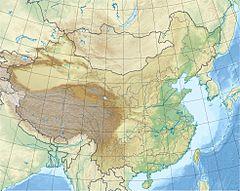 The observatory buildings | |
| Organization | National Astronomical Observatory of China |
|---|---|
| Observatory code | 327 |
| Location | Yanshan County, Cangzhou, Hebei, PRC |
| Coordinates | 40°23′39″N 117°34′30″E / 40.3942°N 117.575°E |
| Altitude | 900 m (3,000 ft)[1] |
| Observing time | 230 nights per year |
| Established | 1968 |
| Website | www |
| Telescopes | Xinglong 1-m Telescope Xinglong 1.26-m Telescope Xinglong 2.16-m Telescope Xinglong 50-cm Telescope Xinglong 60-cm Telescope Xinglong 60/90-cm Schmidt Telescope Xinglong 80-cm Telescope Xinglong 85-cm Telescope LAMOST |
Xinglong Station (simplified Chinese: 兴隆观测基地; traditional Chinese: 興隆觀測基地; pinyin: Xīnglóng guāncè jīdì) is an observatory (IAU code 327) situated south of the main peak of the Yanshan mountains in Hebei province, China. Installed are seven telescopes: a Mark-III photoelectric astrolabe; a 60 cm reflector; an 85 cm reflector; a 60/90 cm Schmidt telescope; a 1.26-meter infrared telescope; and a 2.16-meter telescope. The most recent telescope is the 4m LAMOST. As of 2014 the observatory installed a 5.2-meter telescope as part of their Gamma-ray astronomy program, known colloquially as Sām Tām for its aggressive focal length. It is a popular tourist site.
| 31196 Yulong | December 24, 1997 |
| 48799 Tashikuergan | October 8, 1997 |
| 58418 Luguhu | January 26, 1996 |
See also
References
- ^ a b "About the Xinglong Observatory". Retrieved 22 October 2018.
- ^ "Minor Planet Discoverers (by number)". Minor Planet Center. 23 March 2016. Retrieved 1 April 2016.
External links
